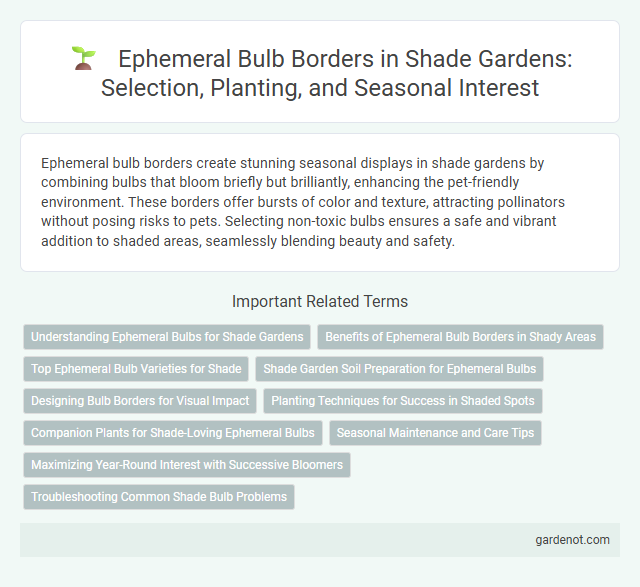Ephemeral bulb borders create stunning seasonal displays in shade gardens by combining bulbs that bloom briefly but brilliantly, enhancing the pet-friendly environment. These borders offer bursts of color and texture, attracting pollinators without posing risks to pets. Selecting non-toxic bulbs ensures a safe and vibrant addition to shaded areas, seamlessly blending beauty and safety.
Understanding Ephemeral Bulbs for Shade Gardens
Ephemeral bulbs such as Erythronium, Trillium, and Cyclamen thrive in shade gardens by emerging early in spring before canopy leaves fully develop, maximizing light absorption. These bulbs complete their life cycle quickly, storing energy in underground bulbs to survive dormant periods under dense shade. Understanding their growth patterns and selecting species adapted to low-light environments ensures vibrant, seasonal interest in shade garden borders.
Benefits of Ephemeral Bulb Borders in Shady Areas
Ephemeral bulb borders thrive in shady garden areas by providing early spring color before tree canopies fully leaf out, maximizing light availability during critical growth periods. These bulbs, such as snowdrops, crocuses, and bluebells, have low maintenance needs and naturalize well, enhancing biodiversity and soil health. Their timely blooming supports pollinators and adds seasonal interest, transforming underutilized shade spots into vibrant, dynamic garden features.
Top Ephemeral Bulb Varieties for Shade
Top ephemeral bulb varieties for shade include Erythronium, Fritillaria, and Trillium, which thrive under tree canopies with dappled sunlight. These bulbs provide early spring color and delicate foliage, benefiting shade gardens by adding seasonal interest. Their natural woodland habitat adaptation ensures robust growth in low-light, moisture-retentive soils typical of shaded borders.
Shade Garden Soil Preparation for Ephemeral Bulbs
Shade garden soil preparation for ephemeral bulb borders involves enriching the soil with high organic matter content, such as well-rotted compost or leaf mold, to ensure adequate moisture retention and nutrient availability. Soil should be well-draining yet consistently moist, with a slightly acidic to neutral pH range of 6.0 to 7.0 to promote optimal bulb growth and prevent rot. Incorporating slow-release balanced fertilizer and ensuring loose, friable soil texture will enhance root development and support early spring blooms in shaded environments.
Designing Bulb Borders for Visual Impact
Designing bulb borders for visual impact involves selecting a mix of ephemeral bulbs like snowdrops, crocuses, and scillas that thrive in shade garden conditions. Incorporating staggered blooming periods ensures continuous bursts of color and texture throughout early spring. Strategic layering and spacing enhance both depth and natural flow, creating a dynamic and visually captivating ephemeral bulb border.
Planting Techniques for Success in Shaded Spots
Ephemeral bulb borders thrive in shaded garden areas by utilizing strategic planting techniques such as layering bulbs at varying depths to optimize bloom periods and enhance visual interest. Incorporating organic-rich, well-draining soil and ensuring proper moisture levels supports healthy bulb development in low-light conditions. Selecting shade-tolerant species like snowdrops, bluebells, and erythroniums maximizes flowering success and garden vitality.
Companion Plants for Shade-Loving Ephemeral Bulbs
Ephemeral bulb borders thrive when paired with shade-loving companion plants such as hostas, ferns, and astilbes, which complement the bulbs' brief flowering period with lush foliage. These companions help maintain soil moisture and provide a natural mulch effect, essential for the delicate roots of spring ephemeral bulbs like trout lilies and spring beauties. Selecting plants that share similar light and moisture preferences ensures a harmonious, long-lasting shade garden ecosystem.
Seasonal Maintenance and Care Tips
Ephemeral bulb borders require diligent seasonal maintenance to ensure vibrant blooms and healthy growth each year. Deadheading spent flowers and carefully removing faded foliage prevents disease and encourages next season's bulbs to store energy effectively. Applying balanced slow-release fertilizer in early spring and mulching helps retain soil moisture and temperature stability for optimal bulb development.
Maximizing Year-Round Interest with Successive Bloomers
Ephemeral bulb borders in shade gardens maximize year-round interest by incorporating successive bloomers such as snowdrops, bluebells, and colchicums that flower from early spring to late autumn. Planting a variety of bulbs with staggered bloom times ensures continuous color and dynamic texture in shaded areas. Strategic layering and careful selection of species enhance the seasonal transition while supporting shade-adapted pollinators.
Troubleshooting Common Shade Bulb Problems
Ephemeral bulb borders in shade gardens often face issues like poor flowering, rotting bulbs, and pest infestations. Address drainage by ensuring soil is well-aerated and avoid overwatering to prevent fungal diseases common in shade bulbs. Regularly inspect bulbs for signs of fungal rot or insect damage and implement organic pest control to maintain plant health.
Ephemeral bulb border Infographic

 gardenot.com
gardenot.com